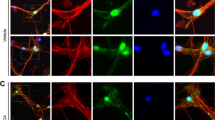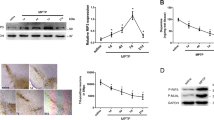Abstract
Apoptosis is a widely accepted component of the pathogenesis of Parkinson's disease (PD), a debilitating neurodegenerative disorder characterized by loss of dopaminergic neurons in the substantia nigra. However, additional death programs were implicated, and current understanding of the cycle of intracellular events that leads to the demise of these neuronJis limited. Gene therapy strategies were proposed to inhibit apoptosis, but they have met with relatively limited success. Here we report that the antiapoptotic herpes simplex virus type 2 gene ICP10PK protects neuronally differentiated PC12 cells from death caused by 1-methyl-4-phenylpyridinium (in vitro PD model) through inhibition of calpain I activation and the resulting inhibition of Bax translocation to the mitochondria, apoptosis-inducing factor release and caspase-3 activation. Neuroprotection is through ICP10PK-mediated activation of the PI3-K/Akt survival pathway and upregulation/stabilization of the antiapoptotic protein Bcl-2 and the cytoprotective chaperone heat-shock protein 70.
This is a preview of subscription content, access via your institution
Access options
Subscribe to this journal
Receive 12 print issues and online access
$259.00 per year
only $21.58 per issue
Buy this article
- Purchase on Springer Link
- Instant access to full article PDF
Prices may be subject to local taxes which are calculated during checkout









Similar content being viewed by others
References
Yuan H, Zheng JC, Liu P, Zhang SF, Xu JY, Bai LM . Pathogenesis of Parkinson's disease: oxidative stress, environmental impact factors and inflammatory processes. Neurosci Bull 2007; 23: 125–130.
Dawson TM, Dawson VL . Neuroprotective and neurorestorative strategies for Parkinson's disease. Nat Neurosci 2002; 5 (Suppl): 1058–1061.
Shastry BS . Parkinson disease: etiology, pathogenesis and future of gene therapy. Neurosci Res 2001; 41: 5–12.
Do Thi NA, Saillour P, Ferrero L, Paunio T, Mallet J . Does neuronal expression of GDNF effectively protect dopaminergic neurons in a rat model of Parkinson's disease? Gene Therapy 2007; 14: 441–450.
Chu CT, Zhu JH, Cao G, Signore A, Wang S, Chen J . Apoptosis inducing factor mediates caspase-independent 1-methyl-4-phenylpyridinium toxicity in dopaminergic cells. J Neurochem 2005; 94: 1685–1695.
Choi WS, Lee EH, Chung CW, Jung YK, Jin BK, Kim SU et al. Cleavage of Bax is mediated by caspase-dependent or -independent calpain activation in dopaminergic neuronal cells: protective role of Bcl-2. J Neurochem 2001; 77: 1531–1541.
Liou AK, Zhou Z, Pei W, Lim TM, Yin XM, Chen J . BimEL up-regulation potentiates AIF translocation and cell death in response to MPTP. FASEB J 2005; 19: 1350–1352.
Crocker SJ, Smith PD, Jackson-Lewis V, Lamba WR, Hayley SP, Grimm E et al. Inhibition of calpains prevents neuronal and behavioral deficits in an MPTP mouse model of Parkinson's disease. J Neurosci 2003; 23: 4081–4091.
Quigney DJ, Gorman AM, Samali A . Heat shock protects PC12 cells against MPP+ toxicity. Brain Res 2003; 993: 133–139.
Grandas F . The putative neuroprotective role of dopamine agonists in Parkinson's disease. Neurotox Res 2000; 2: 205–213.
Golembewski EK, Wales SQ, Aurelian L, Yarowsky PJ . The HSV-2 protein ICP10PK prevents neuronal apoptosis and loss of function in an in vivo model of neurodegeneration associated with glutamate excitotoxicity. Exp Neurol 2007; 203: 381–393.
Wales SQ, Li B, Laing JM, Aurelian L . The herpes simplex virus type 2 gene ICP10PK protects from apoptosis caused by nerve growth factor deprivation through inhibition of caspase-3 activation and XIAP up-regulation. J Neurochem 2007; 103: 365–379.
Gober MD, Laing JM, Thompson SM, Aurelian L . The growth compromised HSV-2 mutant DeltaRR prevents kainic acid-induced apoptosis and loss of function in organotypic hippocampal cultures. Brain Res 2006; 1119: 26–39.
Laing JM, Gober MD, Golembewski EK, Thompson SM, Gyure KA, Yarowsky PJ et al. Intranasal administration of the growth-compromised HSV-2 vector DeltaRR prevents kainate-induced seizures and neuronal loss in rats and mice. Mol Ther 2006; 13: 870–881.
Perkins D, Pereira EF, Aurelian L . The herpes simplex virus type 2 R1 protein kinase (ICP10 PK) functions as a dominant regulator of apoptosis in hippocampal neurons involving activation of the ERK survival pathway and upregulation of the antiapoptotic protein Bag-1. J Virol 2003; 77: 1292–1305.
Perkins D, Pereira EF, Gober M, Yarowsky PJ, Aurelian L . The herpes simplex virus type 2 R1 protein kinase (ICP10 PK) blocks apoptosis in hippocampal neurons, involving activation of the MEK/MAPK survival pathway. J Virol 2002; 76: 1435–1449.
Laing JM, Golembewski EK, Wales SQ, Liu J, Jafri MS, Yarowsky PJ et al. Growth-compromised HSV-2 vector DeltaRR protects from N-methyl-D-aspartate-induced neuronal degeneration through redundant activation of the MEK/ERK and PI3-K/Akt survival pathways, either one of which overrides apoptotic cascades. J Neurosci Res 2008; 86: 378–391.
Hurley MJ, Mash DC, Jenner P . Markers for dopaminergic neurotransmission in the cerebellum in normal individuals and patients with Parkinson's disease examined by RT–PCR. Eur J Neurosci 2003; 18: 2668–2672.
Hartmann A, Hunot S, Michel PP, Muriel MP, Vyas S, Faucheux BA et al. Caspase-3: a vulnerability factor and final effector in apoptotic death of dopaminergic neurons in Parkinson's disease. Proc Natl Acad Sci USA 2000; 97: 2875–2880.
Yang Y, Kaul S, Zhang D, Anantharam V, Kanthasamy AG . Suppression of caspase-3-dependent proteolytic activation of protein kinase C delta by small interfering RNA prevents MPP+-induced dopaminergic degeneration. Mol Cell Neurosci 2004; 25: 406–421.
Bilsland J, Roy S, Xanthoudakis S, Nicholson DW, Han Y, Grimm E et al. Caspase inhibitors attenuate 1-methyl-4-phenylpyridinium toxicity in primary cultures of mesencephalic dopaminergic neurons. J Neurosci 2002; 22: 2637–2649.
Cao G, Xing J, Xiao X, Liou AK, Gao Y, Yin XM et al. Critical role of calpain I in mitochondrial release of apoptosis-inducing factor in ischemic neuronal injury. J Neurosci 2007; 27: 9278–9293.
Daniel KG, Anderson JS, Zhong Q, Kazi A, Gupta P, Dou QP . Association of mitochondrial calpain activation with increased expression and autolysis of calpain small subunit in an early stage of apoptosis. Int J Mol Med 2003; 12: 247–252.
Hayashi M, Inomata M, Saito Y, Ito H, Kawashima S . Activation of intracellular calcium-activated neutral proteinase in erythrocytes and its inhibition by exogenously added inhibitors. Biochim Biophys Acta 1991; 1094: 249–256.
Hartmann A, Michel PP, Troadec JD, Mouatt-Prigent A, Faucheux BA, Ruberg M et al. Is Bax a mitochondrial mediator in apoptotic death of dopaminergic neurons in Parkinson's disease? J Neurochem 2001; 76: 1785–1793.
Gurbuxani S, Schmitt E, Cande C, Parcellier A, Hammann A, Daugas E et al. Heat shock protein 70 binding inhibits the nuclear import of apoptosis-inducing factor. Oncogene 2003; 22: 6669–6678.
Perkins D, Gyure KA, Pereira EF, Aurelian L . Herpes simplex virus type 1-induced encephalitis has an apoptotic component associated with activation of c-Jun N-terminal kinase. J Neurovirol 2003; 9: 101–111.
Samantaray S, Knaryan VH, Guyton MK, Matzelle DD, Ray SK, Banik NL . The parkinsonian neurotoxin rotenone activates calpain and caspase-3 leading to motoneuron degeneration in spinal cord of Lewis rats. Neuroscience 2007; 146: 741–755.
Schoenwaelder SM, Kulkarni S, Salem HH, Imajoh-Ohmi S, Yamao-Harigaya W, Saido TC et al. Distinct substrate specificities and functional roles for the 78- and 76-kDa forms of mu-calpain in human platelets. J Biol Chem 1997; 272: 24876–24884.
Klafki H, Abramowski D, Swoboda R, Paganetti PA, Staufenbiel M . The carboxyl termini of beta-amyloid peptides 1–40 and 1–42 are generated by distinct gamma-secretase activities. J Biol Chem 1996; 271: 28655–28659.
Gao G, Dou QP . N-terminal cleavage of bax by calpain generates a potent proapoptotic 18-kDa fragment that promotes bcl-2-independent cytochrome c release and apoptotic cell death. J Cell Biochem 2000; 80: 53–72.
Smith CC, Luo JH, Hunter JCR, Ordonez JV, Aurelian L . The transmembrane domain of the large subunit of HSV-2 ribonucleotide reductase (ICP10) is required for protein kinase activity and transformation-related signaling pathways that result in ras activation. Virology 1994; 200: 598–612.
Smith CC, Nelson J, Aurelian L, Gober M, Goswami BB . Ras-GAP binding and phosphorylation by herpes simplex virus type 2 RR1 PK (ICP10) and activation of the Ras/MEK/MAPK mitogenic pathway are required for timely onset of virus growth. J Virol 2000; 74: 10417–10429.
Magrane J, Rosen KM, Smith RC, Walsh K, Gouras GK, Querfurth HW . Intraneuronal beta-amyloid expression downregulates the Akt survival pathway and blunts the stress response. J Neurosci 2005; 25: 10960–10969.
Eberhardt O, Schulz JB . Apoptotic mechanisms and antiapoptotic therapy in the MPTP model of Parkinson's disease. Toxicol Lett 2003; 139: 135–151.
Smeyne RJ, Jackson-Lewis V . The MPTP model of Parkinson's disease. Brain Res Mol Brain Res 2005; 134: 57–66.
Tatton NA . Increased caspase 3 and Bax immunoreactivity accompany nuclear GAPDH translocation and neuronal apoptosis in Parkinson's disease. Exp Neurol 2000; 166: 29–43.
Yang L, Matthews RT, Schulz JB, Klockgether T, Liao AW, Martinou J-C et al. 1-Methyl-4-phenyl-1,2,3,6-tetrahydropyride neurotoxicity is attenuated in mice overexpressing Bcl-2. J Neurosci 1998; 18: 8145–8152.
Zhang D, Zhang JJ, Liu GT . The novel squamosamide derivative (compound FLZ) attenuated 1-methyl,4-phenyl-pyridinium ion (MPP+)-induced apoptosis and alternations of related signal transduction in SH-SY5Y cells. Neuropharmacology 2007; 52: 423–429.
Han BS, Hong HS, Choi WS, Markelonis GJ, Oh TH, Oh YJ . Caspase-dependent and -independent cell death pathways in primary cultures of mesencephalic dopaminergic neurons after neurotoxin treatment. J Neurosci 2003; 23: 5069–5078.
Shacka JJ, Roth KA, Zhang J . The autophagy-lysosomal degradation pathway: role in neurodegenerative disease and therapy. Front Biosci 2008; 13: 718–736.
Takano J, Tomioka M, Tsubuki S, Higuchi M, Iwata N, Itohara S et al. Calpain mediates excitotoxic DNA fragmentation via mitochondrial pathways in adult brains: evidence from calpastatin mutant mice. J Biol Chem 2005; 280: 16175–16184.
Porn-Ares MI, Samali A, Orrenius S . Cleavage of the calpain inhibitor, calpastatin, during apoptosis. Cell Death Differ 1998; 5: 1028–1033.
Bizat N, Hermel JM, Humbert S, Jacquard C, Creminon C, Escartin C et al. In vivo calpain/caspase cross-talk during 3-nitropropionic acid-induced striatal degeneration: implication of a calpain-mediated cleavage of active caspase-3. J Biol Chem 2003; 278: 43245–43253.
Blomgren K, Zhu C, Wang X, Karlsson JO, Leverin AL, Bahr BA et al. Synergistic activation of caspase-3 by m-calpain after neonatal hypoxia-ischemia: a mechanism of ‘pathological apoptosis’? J Biol Chem 2001; 276: 10191–10198.
Singh S, Dikshit M . Apoptotic neuronal death in Parkinson's disease: involvement of nitric oxide. Brain Res Rev 2007; 54: 233–250.
Eberhardt O, Coelln RV, Kugler S, Lindenau J, Rathke-Hartlieb S, Gerhardt E et al. Protection by synergistic effects of adenovirus-mediated X-chromosome-linked inhibitor of apoptosis and glial cell line-derived neurotrophic factor gene transfer in the 1-methyl-4-phenyl-1,2,3,6-tetrahydropyridine model of Parkinson's disease. J Neurosci 2000; 20: 9126–9134.
Sano M, Nishiyama K, Kitajima S . A nerve growth factor-dependent protein kinase that phosphorylates microtubule-associated proteins in vitro: possible involvement of its activity in the outgrowth of neurites from PC12 cells. J Neurochem 1990; 55: 427–435.
Luo JH, Smith CC, Kulka M, Aurelian L . A truncated protein kinase domain of the large subunit of herpes simplex virus type 2 ribonucleotide reductase (ICP10) expressed in Escherichia coli. J Biol Chem 1991; 266: 20976–20983.
Author information
Authors and Affiliations
Corresponding author
Additional information
Supplementary Information accompanies the paper on Gene Therapy website (http://www.nature.com/gt)
Rights and permissions
About this article
Cite this article
Wales, S., Laing, J., Chen, L. et al. ICP10PK inhibits calpain-dependent release of apoptosis-inducing factor and programmed cell death in response to the toxin MPP+. Gene Ther 15, 1397–1409 (2008). https://doi.org/10.1038/gt.2008.88
Received:
Revised:
Accepted:
Published:
Issue Date:
DOI: https://doi.org/10.1038/gt.2008.88
Keywords
This article is cited by
-
The interplay between human herpes simplex virus infection and the apoptosis and necroptosis cell death pathways
Virology Journal (2016)
-
Calpain-dependent clearance of the autophagy protein p62/SQSTM1 is a contributor to ΔPK oncolytic activity in melanoma
Gene Therapy (2014)
-
Calpain Plays a Central Role in 1-Methyl-4-phenylpyridinium (MPP(+))-Induced Neurotoxicity in Cerebellar Granule Neurons
Neurotoxicity Research (2011)
-
The HSV-2 mutant ΔPK induces melanoma oncolysis through nonredundant death programs and associated with autophagy and pyroptosis proteins
Gene Therapy (2010)



